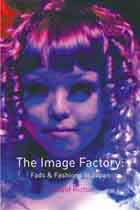2 books about Fads

Fashionable Food
Seven Decades of Food Fads
Sylvia Lovegren
University of Chicago Press, 2005
Though the Roaring Twenties call to mind images of flappers dancing the Charleston and gangsters dispensing moonshine in back rooms, Sylvia Lovegren here playfully reminds us what these characters ate for dinner: Banana and Popcorn Salad. Like fashions and fads, food—even bad food—has a history, and Lovegren's Fashionable Food is quite literally a cookbook of the American past.
Well researched and delightfully illustrated, this collection of faddish recipes from the 1920s to the 1990s is a decade-by-decade tour of a hungry American century. From the Three P's Salad—that's peas, pickles, and peanuts—of the post-World War I era to the Fruit Cocktail and Spam Buffet Party loaf—all the rage in the ultra-modern 1950s, when cooking from a can epitomized culinary sophistication—Fashionable Food details the origins of these curious delicacies. In two chapters devoted to "exotic foods of the East," for example, Lovegren explores the long American love affair with Chinese food and the social status conferred upon anyone chic enough to eat pu-pu platters from Polynesia. Throughout, Lovegren supplements recipes—some mouth-watering, some appalling—from classic cookbooks and family magazines, with humorous anecdotes that chronicle how society and kitchen technology influenced the way we lived and how we ate.
Equal parts American and culinary history, Fashionable Food examines our collective past from the kitchen counter. Even if it's been a while since you last had Tang Pie and your fondue set is collecting dust in the back of the cupboard, Fashionable Food will inspire, entertain, and inform.
Well researched and delightfully illustrated, this collection of faddish recipes from the 1920s to the 1990s is a decade-by-decade tour of a hungry American century. From the Three P's Salad—that's peas, pickles, and peanuts—of the post-World War I era to the Fruit Cocktail and Spam Buffet Party loaf—all the rage in the ultra-modern 1950s, when cooking from a can epitomized culinary sophistication—Fashionable Food details the origins of these curious delicacies. In two chapters devoted to "exotic foods of the East," for example, Lovegren explores the long American love affair with Chinese food and the social status conferred upon anyone chic enough to eat pu-pu platters from Polynesia. Throughout, Lovegren supplements recipes—some mouth-watering, some appalling—from classic cookbooks and family magazines, with humorous anecdotes that chronicle how society and kitchen technology influenced the way we lived and how we ate.
Equal parts American and culinary history, Fashionable Food examines our collective past from the kitchen counter. Even if it's been a while since you last had Tang Pie and your fondue set is collecting dust in the back of the cupboard, Fashionable Food will inspire, entertain, and inform.
[more]

Image Factory
Fads and Fashions in Japan
Donald Richie
Reaktion Books, 2003
Just as a person contrives a style, the purpose of which is integration and the effect of which is presentation, so a nation collectively projects an appearance, a "national" style. Such styles are made of many layers. The deepest layer is composed of the immutable and the traditional. Nearer the surface floats fashion, changeable but sometimes more abiding. And frothing on the surface is fad.
By definition a fad is novel and appears from outside. Fads must have instant appeal and do not have a long shelf life. In Japan, an assortment of islands, the outside is often the quality that defines the inside.
Japan has a history of chasing fads and fashion. Since the 19th century, foreign products have been welcomed in, from the cult for "squeaky shoes" in the mid-19th century to the current fad for virtual reality girlfriends. Japan’s mandate was that, having been opened late, it had to hurry to catch up. Fads provide both a social distraction and a sense of cohesion, indicating not only foreign importation but also native adaptation.
The Image Factory is both an investigation into fads, fashions and style – such as US Army surplus uniforms, "pachinko", mutating hair colors – and an appreciation of their inherent meanings. The Japanese have seized upon fads and fashion as an arm of enterprise to a much greater extent than elsewhere in the world. Ephemerality has been put to work, the transient has become industrialized, and the results are highly conspicuous.
By definition a fad is novel and appears from outside. Fads must have instant appeal and do not have a long shelf life. In Japan, an assortment of islands, the outside is often the quality that defines the inside.
Japan has a history of chasing fads and fashion. Since the 19th century, foreign products have been welcomed in, from the cult for "squeaky shoes" in the mid-19th century to the current fad for virtual reality girlfriends. Japan’s mandate was that, having been opened late, it had to hurry to catch up. Fads provide both a social distraction and a sense of cohesion, indicating not only foreign importation but also native adaptation.
The Image Factory is both an investigation into fads, fashions and style – such as US Army surplus uniforms, "pachinko", mutating hair colors – and an appreciation of their inherent meanings. The Japanese have seized upon fads and fashion as an arm of enterprise to a much greater extent than elsewhere in the world. Ephemerality has been put to work, the transient has become industrialized, and the results are highly conspicuous.
[more]
READERS
Browse our collection.
PUBLISHERS
See BiblioVault's publisher services.
STUDENT SERVICES
Files for college accessibility offices.
UChicago Accessibility Resources
home | accessibility | search | about | contact us
BiblioVault ® 2001 - 2024
The University of Chicago Press









